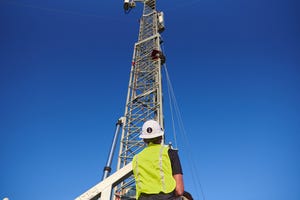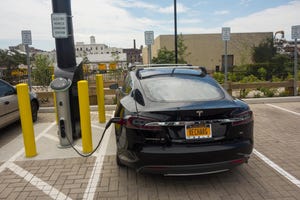Three CTO on Vodafone merger: 'Spectrum asymmetry is good'
Three's technology chief, David Hennessy, dismisses suggestions that Vodafone and Three should be stripped of spectrum if their deal goes ahead and says the densified network would put needed pressure on rivals.

Ever since it launched the UK's inaugural 3G service in March 2003, the operator that named itself after the technology has languished as the smallest of the UK's four mobile networks. Three thinks that's too many to compete effectively and would like the number of networks to reflect its name, as well. If its planned merger with Vodafone is approved by regulators, Three's wish will come true. But it might have to relinquish some assets as a condition of the deal.
That's a problem for David Hennessy, Three's chief technology officer. After mopping up spectrum via previous acquisitions and government-run auctions, Three sprawls across the valuable C-band, the frequency range considered a 5G sweet spot, holding about 36% of it. A merger with Vodafone would leave the combined entity with about 59% of this band and nearly half of all the frequencies licensed to the telecom sector, according to data published by Ofcom, the UK telecom regulator. Authorities may push for a redistribution of this spectrum wealth, weakening Vodafone and Three in the process. Hennessy, unsurprisingly, hits back at rivals urging those authorities to act.
"I would not be entertaining some of the noise being made by other operators on the C-band or spectrum holdings generally, because asymmetry is good," he told Light Reading this week. "Nobody said that spectrum holdings should be symmetrical. There are auctions and, if you want more spectrum, you can buy it in the auctions."
Spectrum asymmetry has long appeared to be a characteristic of the UK telecom market. Before Three picked up sub-1GHz licenses and paid £250 million (US$317 million at today's exchange rate) for the frequency-rich UK Broadband – which, given recent auctions, now seems like the spectrum deal of the century – it had been the pauper of the telco pack, holding none of the lowband airwaves originally given out for use with 2G services. It was a "different-shaped asymmetry," Hennessy wryly points out, and one that clearly suited the larger telcos now grumbling.
'Not challenged to invest'
But a deal would catapult Vodafone and Three past BT and Virgin Media O2 (VMO2), establishing it as the UK's biggest mobile operator. Executives within other telcos are worried that Vodafone-Three would have a massive lead on sites as well as spectrum. "Currently, there are four operators with between 18,000 and 20,000 sites each," said Hennessy. Adding Vodafone's tally to Three's would produce a network of more than 36,000 sites.
Maintaining such a high number in a country of the UK's size is certainly not the intention, according to Hennessy. But the plan is for the new-look operator to have more than either Vodafone or Three individually operates now. And Three's head technology executive evidently believes this instant densification would help address some of the network shortcomings he sees in the UK.
"I feel very, very strongly about this but the UK networks lag a lot behind first-world peers," Hennessy said. "In a four-player market, the amount of investment you need to do 5G and 4G well is spread too thinly. You need concentration." In the current market environment, the biggest players are "not challenged to invest," he added.
Three's case is that its merger with Vodafone would provide this challenge. "We are targeting a network of almost 26,000 sites, and if that forced investment from VMO2 and BT, they may go to the same," Hennessy said. "If they need to build more sites, I think that is a good thing. If they need to invest to deploy more of the spectrum that they already have across their existing sites, I think that is a good thing too because citizens will get a better experience."
Ultimately, this should mean there is no meaningful reduction in overall site numbers but what Hennessy calls a "reconfiguration." The related thornier issue, perhaps, is what to do about MBNL and Beacon, the UK's two mast-sharing joint ventures (JVs). Three participates in MBNL alongside BT, while Vodafone and VMO2 are active in Beacon. A tie-up would have a foot in each camp and might conceivably be able to exploit this position to the detriment of rivals. The likeliest "remedy" demanded by the Competition and Markets Authority is that Vodafone-Three withdraw from one of the JVs.
It's a topic on which Hennessy says he is unable to comment while the merger plans are under review. But any such withdrawal would look difficult to execute, simply because each telco is heavily reliant on its JV's masts as the supporting infrastructure for its basestations. At the same time, however, Vodafone-Three's plan to shrink the site total from more than 36,000 to "almost 26,000" implies taking many of those basestations out of service.
Basestation rationalization
Bar China's ZTE, just about every big mobile equipment vendor is currently in the mix across the operators' combined footprint. Based on data previously disclosed by Scott Petty, now chief technology officer of Vodafone Group, Ericsson serves (or will serve) about 15,500 of Vodafone's roughly 18,000 sites. The remainder, until now, have been equipped by Huawei, but the Chinese vendor's technology will have to be removed by the end of 2027 to comply with newish government rules about the use of "high-risk vendors."
Instead, Vodafone is shifting these 2,500 sites to an "open" radio access network (RAN), where compatible parts can be obtained from numerous suppliers instead of one vendor's system. Most of the critical parts, though, are to come from South Korea's Samsung, previously identified as a provider of both RAN software and radio units to Vodafone.
Data for Three is less granular. What's known is that it has used a different vendor for each generation of mobile technology, building 3G with Nokia and 4G with Samsung before starting off with Huawei in 5G. That rollout was halted when the government began to clamp down on Huawei. Three quickly switched to Ericsson, now its primary RAN vendor. Yet all three legacy suppliers are still in use.
Without disclosing site numbers, Hennessy said Three met last July's government deadline for limiting Huawei to just 35% of all RAN sites. By July this year, it will also need to prove that no more than 35% of traffic for the preceding 12 months ran over Huawei's products. "We're on track to comply with that as well," he said.
Three's entire 3G network still runs on Nokia equipment, but the standard that gave the operator its name is quickly being phased out. "We are switching it off progressively," said Hennessy. "We did some last year and will do some this year and the final part is hopefully next year." Samsung, meanwhile, is being replaced as Three deploys new Ericsson kit. But the technology still "works well," according to Hennessy, and there are clearly no government-imposed deadlines for its removal. "Samsung isn't really a burning platform," he said.
The big challenge for an operator struggling to make a return on its investment (ROI) – the situation Three claims to be in – is knowing what to prioritize. "There are always lots of competing objectives with what to do with capex," said Hennessy. "Do you roll out more 5G in London or replace Samsung 4G in rural areas or deploy more 4G where there is 3G only?"
Nevertheless, ditching older equipment and moving to a smaller number of vendors should ideally make Three more efficient. "The more you can simplify, the better," said Hennessy. If the merger with Vodafone does win approval, and works out as planned, those ROI concerns should also start to fade, provided any remedies are not stringent. For Hennessy and other senior executives at the table, the decisions made in the next few months will be critical.
Read more about:
EuropeAbout the Author(s)
You May Also Like












